Welcome to the landscape photography blog by Chuck Derus. Thanks for looking and for your comments!
Long Dong Silver


Is it Middle Earth? Are we on the set of Lord of the Rings? Where are these rock spires that majestically arise out of nowhere?
There’re actually near Hanksville, Utah. Hidden between towering cliffs, these twin black spires jut dramatically up and out of the ground. They were once part of an unbroken layer of sand and rock surrounded by cliffs.
But millions of years of erosion created a natural amphitheater. And for unknown reasons, only a lone pair of stoic shale spires remains in the middle.
An Unusual Name
This strange and fascinating formation goes by many names. A few refer to it as The Spire or The Needle. But it’s best known as Long Dong Silver.
That’s the stage name of retired British porn star Daniel Arthur Mead. His moniker was inspired by a play on words of the fictional Treasure Island character Long John Silver.
He appeared in several pornographic movies in the UK and US during the late 1970s and early 1980s. The actor reached a new audience in the wake of allegations of sexual harassment during the Clarence Thomas Supreme Court nomination in the US Senate in 1991. Anita Hill alleged that Thomas mentioned to her that he was a viewer of Long Dong Silver's films.
The Shot
Last October 28 I was in Hanksville, Utah with friends Steve Horne and Scott Fuller. We decided to visit and attempt to photograph this spellbinding formation.
The location isn’t marked. You must drive to GPS coordinates on the highway and then follow an unmarked dirt road for about a mile. After parking there, it’s about a 1.5-mile hike until you spot the spires.
I almost turned back. There was nothing notable for over a mile. It isn’t until the last few hundred yards that the formation came into view.
We did our best to take an interesting photograph. Nothing seemed to work. Out of curiosity, I took out my drone and circled the formation.
What a difference! As the sun set, I discovered this composition. I enjoyed how the spires seemed to line up with the setting sun.
Because there was sufficient battery power remaining, I kept flying. After the sun set, a view in the opposite direction caught the last light on the clouds.
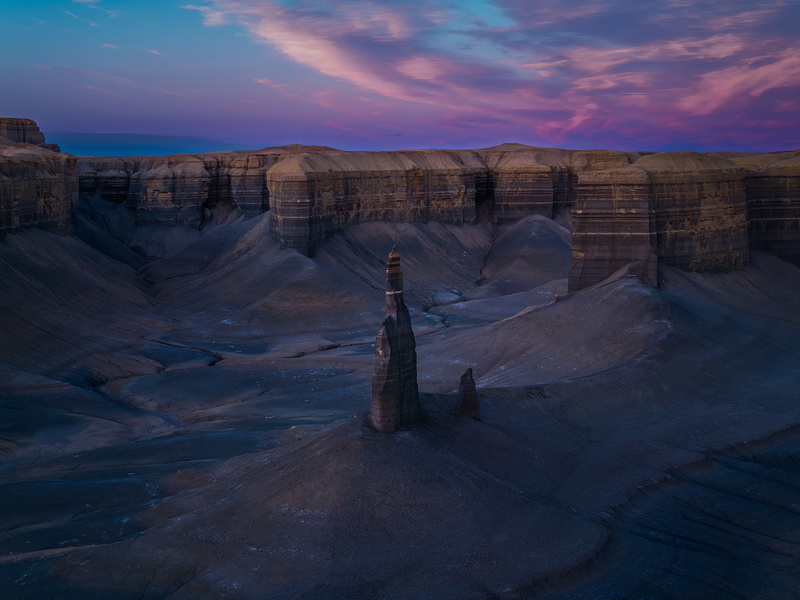

Thanks for looking,
Chuck Derus
Animal Portraits


Up close and personal. The word portrait evokes a frame-filling face or full body shot of the species. Who would travel to Africa’s Serengeti without longing to capture a viewfinder-filling image of a zebra, for example?
The usual goal of an animal portrait is to reveal an adorable expression, capture a defining behavior, or to showcase a majestic coat of fur or colorful feathers. Ideally, only the animal is in focus with the background blurred. This way, the subject stands out with no distractions.
The photographer’s lens of choice is a big telephoto lens. It does a superb job of filling the frame and blurring the background.
But there is another kind of portrait. An environmental portrait is a landscape image with an animal included. Using a normal or short telephoto lens allows the photographer to show off the animal in its domain. The focus is about storytelling rather than documentation.
Wildlife Photos?
If you follow the Friday Photo, you know that if it moves, I don’t usually photograph it. But there are exceptions.
Last April in Patagonia, we had the opportunity to experience some of the wildlife. The South American gray fox, the Patagonian mara (rabbit), the crested cara cara, and the Andean condor all made appearances.
But the most common critter was the guanaco (ghwuah-NAH-koh). It’s a camelid native to South America. You might be more familiar with its domesticated relative, the llama.
Like all camels, Guanacos are herbivores. They graze on grasses, shrubs, herbs, lichens, fungi, cacti, and flowers.
Guanacos live in herds composed of females, their young, and a single dominant male. Around one year of age, young males are expelled from the herd.
The reproductive groups tend to remain small, often containing no more than 10 adults. Bachelor herds may contain as many as 50 males. Though typically mild-mannered, guanacos often spit up to six feet when threatened.
Preyed upon by puma (aka mountain lions), they can run at 35 mph per hour, even over steep and rocky terrain. They are also excellent swimmers. A guanaco's typical lifespan is 20 to 25 years.
The Shot
None of us on the photo tour were wildlife photographers. However, another reason to capture an image of the Andes mountains was appealing. While the mid-afternoon light was terrible for a pure landscape image, it could create magical backlighting of an animal.
As we cruised the road, we kept an eye out for guanaco. After a short drive, we spotted a herd and exited the car. We slowly walked towards them to nudge them into position.
It required 30 minutes or so, but finally we had a solitary guanaco outlined with a glowing halo of fur with the towering Andes in the distance. I hoped this photograph would tell their story.
Thanks for looking,
Chuck Derus
Show Time
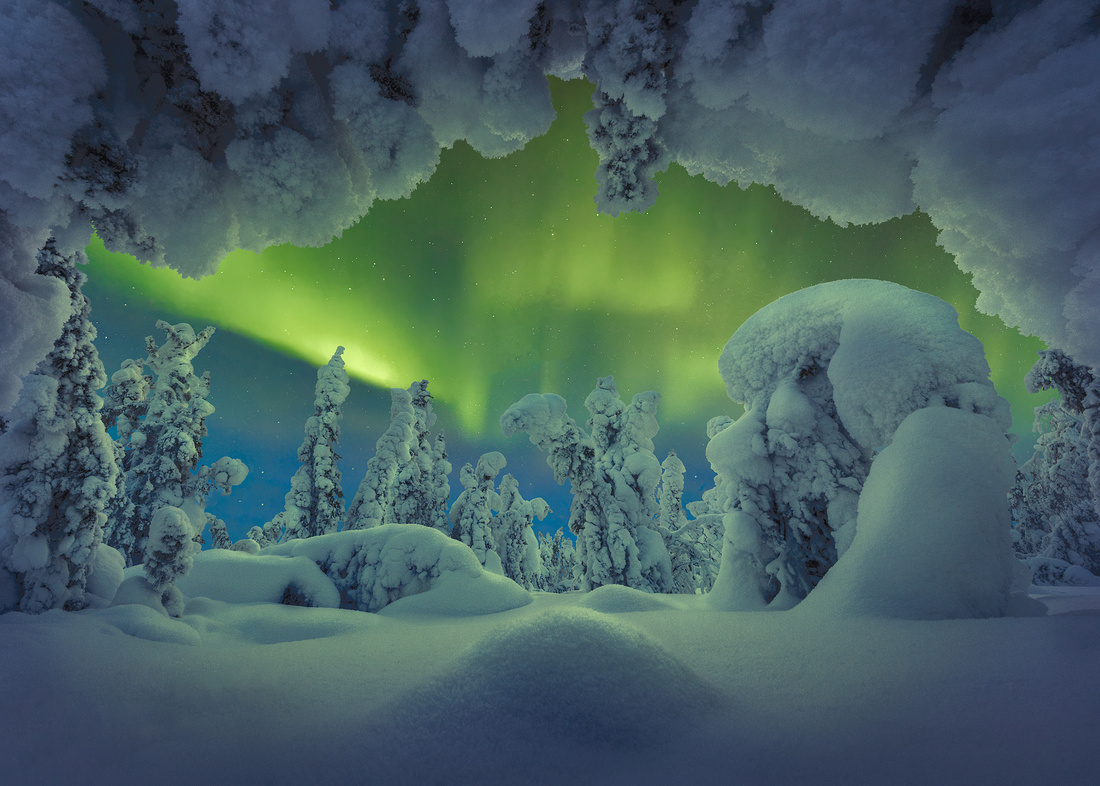

Breathtaking. Enthralling. Dazzling. Words seem inadequate to capture the breathtaking beauty and captivating mystery of the Northern Lights.
Alaskan author Eowyn Ivey comes close in her novel The Snow Child: “She looked directly up into the Northern Lights, and she wondered if those cold-burning specters might not draw her breath, her very soul, out of her chest and into the stars.”
Some cultures believe they are the spirits of ancestors dancing in the sky. Other cultures considered them omens of good fortune and prosperity. Today, we have a scientific explanation for this magical experience.
Each display is one of a kind. The random nature of charged particles from the sun colliding with the Earth’s atmosphere creates unique and unpredictable vibrant displays of greens, pinks, purples, and blues.
Witnessing the Northern Lights is truly a once-in-a-lifetime experience. It leaves an indelible impression that connects us to nature.
The Shot
Wintertime blankets chaotic and distracting foreground details with beautifully simplistic snow. This makes the photographer’s goal of moving the viewer’s eye through the scene much easier.
The rime ice-covered trees bent towards each other creating a wonderful frame for the background. And the small mound of snow in the foreground was an unexpected bonus.
The image is a composite of a pre-dawn image of the foreground and an early evening image of the Northern Lights. Both were taken near Coldfoot, Alaska last February.
Thanks for looking,
Chuck Derus
Back in Time


Factory Butte rises majestically above the alien and barren Caineville, Utah badlands. This striking, menacing sandstone peak appears to be equal parts Mordor and Mars.
The butte was named by early settlers. Its outline resembled the Provo, Utah woolen mill, a huge factory building.
According to photographer Eric Bunch, "Visiting Factory Butte is like going back in time. The views feel ancient and stir my imagination towards images of dinosaurs roaming the land, while cinder cones pour molten lava into the valleys, and the long-lost oceans of blue waters teem with life."
Located just east of Capitol Reef National Park, this 6,302-foot monolith was once home to dusty coal miners. These days, the butte and surrounding lunar-like badlands create a photographer’s wonderland. The root-like combs, crags, and shoulders that snake towards the hilltop give it the appearance of an enormous, ancient rock stump.
The Shot
Last October 29, I was in the area with friends Scott Fuller and Steve Horne. Our attention was focused on Moonscape Overlook to the east of Factory Butte.
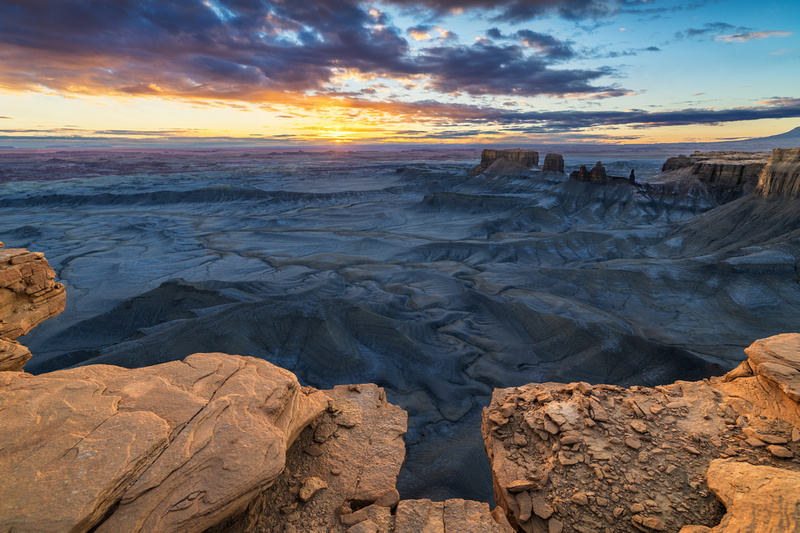

Moonscape Overlook, the opposite direction of Factory Butte
But photographers should always remember to turn around and look behind. As I turned, the morning light began breaking through the clouds and onto the Butte.
I quickly abandoned my “big” camera and launched my drone. Flying towards the massif, I stopped to include a photogenic, smaller feature in the foreground of my composition.
After landing the drone and packing up our gear, it was time to thaw out our hands in the truck while heading back to Duke’s Slickrock Grill for breakfast. Duke’s is the best (and only) restaurant open in nearby Hanksville, Utah during the off-season.
Thanks for looking,
Chuck Derus
River of Black Mud
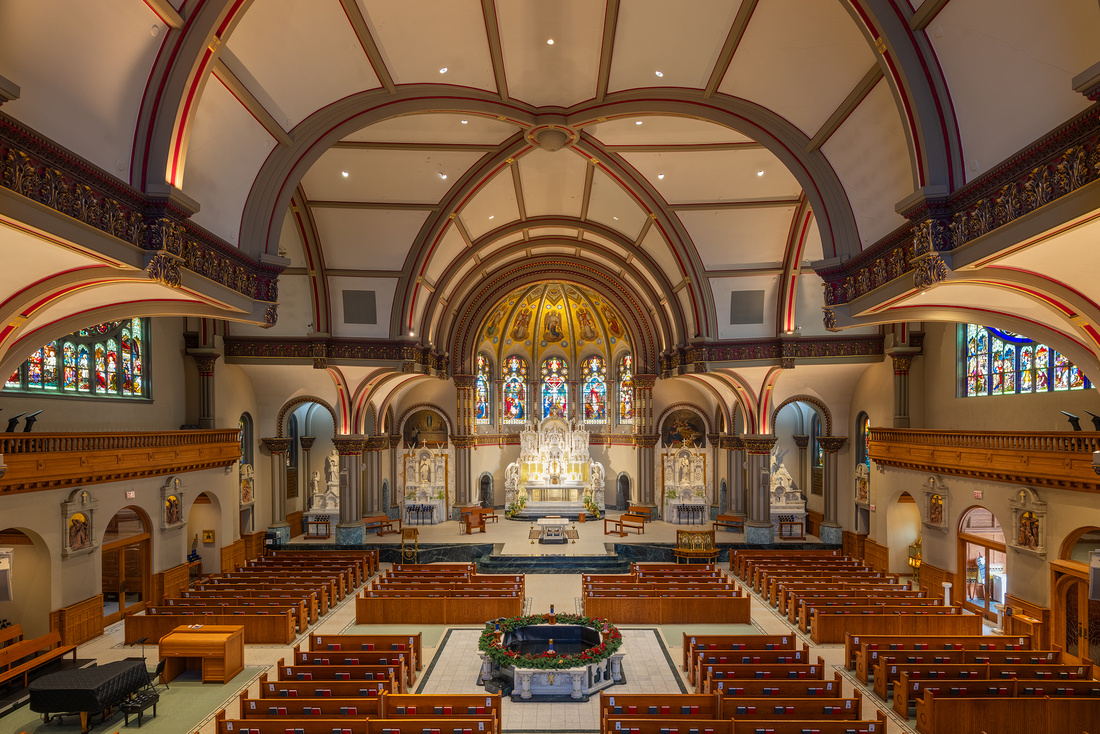

It was 1875. Chicago had been a city for only 38 years. The great fire was merely four years in the past.
That’s when a young priest first set his eyes upon the hardly recognizable intersection of Webster Ave. and Osgood St. (now Kenmore Ave.). It was the barely civilized fringe of Chicago. He saw truck farms, dirt streets that became rivers of black mud in the rain and the snow, and an occasional home breaking the monotony of a sweeping prairie.
Forty-one-year-old Rev. Edward Smith, C.M., had been summoned by the Bishop of Chicago to establish a new parish. He had $5,000 to purchase property and to build a new church. For almost a year, he used the small chapel at nearby St. Joseph Hospital to serve the 75 German and Irish Catholics in the area.
Working with parishioners, he purchased land and commissioned the construction of a small brick building on the corner of Webster and Osgood. On Christmas Day of 1875, they celebrated their first Mass together in the roofless building still under construction.
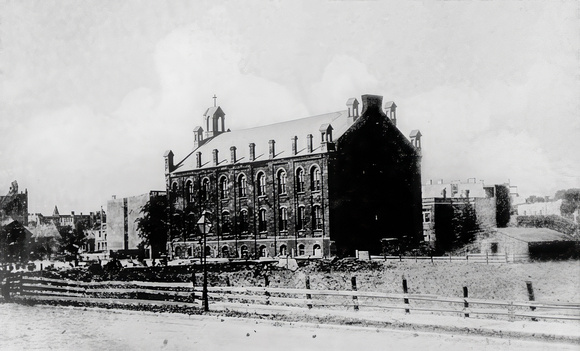

The original St. Vincent de Paul multipurpose building commonly known as “Father Smith’s Farm” from Then & Now · DePaul University 125 Anniversary
The top floor was the church. The first floor the pastor’s home, schoolrooms, and a parish hall. The building was finally finished and dedicated on April 30, 1876.
By 1891, the original building was clearly inadequate to meet the needs of a now booming neighborhood. Planning began for a magnificent replacement church.
It was slow going. The depression following the closing of the 1893 World’s Fair and concerns about the exact location of the elevated railway running from downtown to Wilson Avenue delayed progress.
When the new church was finally dedicated on May 2, 1897, there were few churches that could rival it in grace or architecture. That holds true today, as well.
One of its unique features is unobstructed sightlines. Normally, multiple columns are required for support. Steel supports reduced the number of columns to only four.
With the original building vacated, it was heavily remodeled along with the addition of a third floor. It became the home of the new St. Vincent's College in 1898. That school is now known as DePaul University.
On dedication day, the new church was very plain. The altars and floors were wooden, the walls were bare and most of the windows were plain glass.
It took 17 more years to furnish and decorate the church. Stained-glass windows came from Franz Mayer & Company of Munich, Germany. A first-class Lyon & Healy organ was installed. The High, Blessed Virgin, and St. Joseph Altars were built along with a marble altar rail. The sanctuary was tiled.
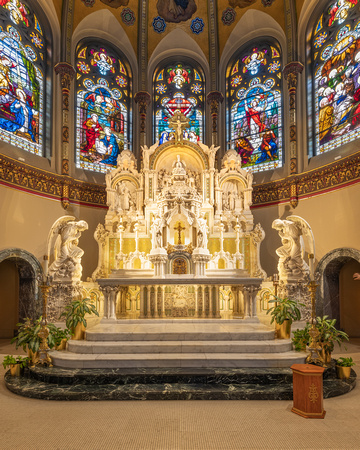

The Carrara marble High Altar
After fire destroyed a large portion of the church interior in 1955, the damaged south Rose window required replacement. The new 22-foot window was created by Conrad Schmitt Studios of New Berlin, Wisconsin. The theme is “Sun of Splendor.”
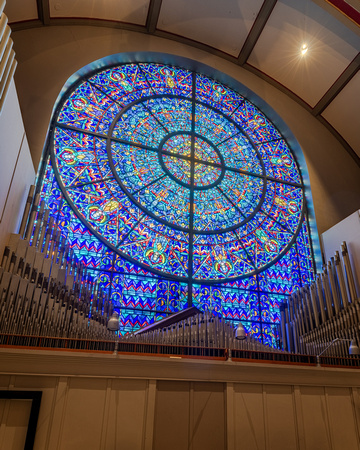

The Rose window replacement and some of the Lyon & Healy organ pipes.
The Shot
The Chicago Streets and Beyond Meetup photography group regularly sponsors photo walks and tours. Ever since my sister-in-law’s wedding there in 1995, I’ve wanted to return to admire its beauty. The Meetup on November 23 was that opportunity.
Thanks for looking and Happy New Year,
Chuck Derus